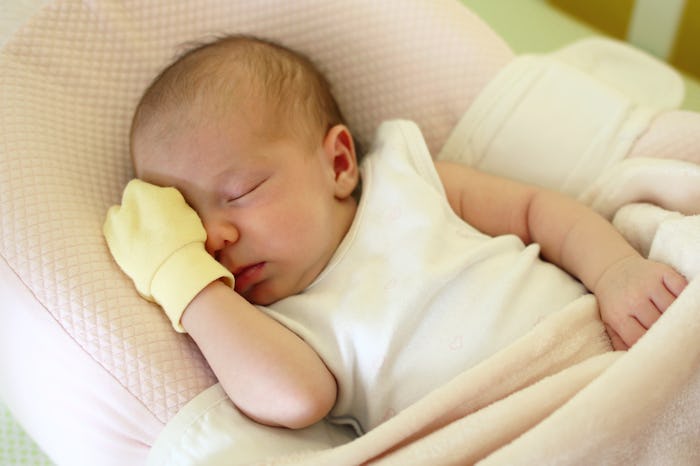Baby

Here's What Experts Want You To Know About Babies Sleeping In Mittens
They’ll prevent scratches, but should be used with caution.
Almost nothing is more precious than a newborn waving their teeny little arms around, looking just like a kitten in socks with protective mittens covering their impossibly sharp fingernails. They're decidedly adorable and serve an important purpose, but can babies sleep in mittens? You definitely don't want your baby's soft, supple newborn skin getting scratched up by their hard-to-trim nails, but you also want to make sure that your baby is safely prepared for sleep, so this question is a pretty logical one to ask.
Benefits Of Babies Sleeping In Mittens
Safe sleep guidelines can be a bit tricky to get a grasp on because the science behind what is and is not OK for an infant with regards to sleep positioning, crib contents, and clothing options is in near-constant flux.
The National Sleep Foundation's recommendation for what an infant should wear to sleep includes protective mittens. "Newborns' fingernails can be sharp and scratch their faces during sleep, so soft mittens can remove that danger," the foundation's website noted. But is a scratch on their face more dangerous than the potential hazards that a mitten that accidentally comes off of a baby's hand in their sleep may pose?
"There are no real benefits to infants wearing mittens. Even if babies scratch their faces, those kinds of scratches don’t cause scarring or long-term effects," Dr. Stephanie Hemm, pediatrician at LifeBridge Health Pediatrics at Loch Raven tells Romper.
Still, as a new parent, you might worry about your baby accidentally scratching their eyeball or even a scratch disturbing their slumber when you are absolutely desperate for them to get some sleep. So what is a concerned parent to do? Experts say you should weigh the pros and cons of wearing mittens or not, as well as explore alternatives.
Safety Concerns For Babies Sleeping In Mittens
"Unless there is a compelling reason to use ‘tools’ such as excessive scratching due to eczema or self-harm, it’s probably optimal to avoid tools," Daniel Lewin, associate director of the Pediatric Sleep Medicine Program at Children’s National Hospital tells Romper, explaining that mittens are one such “tool” used by parents. "Aside from obvious hazards such as the mittens falling off or being too tight, there are probably no specific hazards. Normal mobility of hands during wake and sleep periods may be optimal for development, but this is not likely to be a hazard. Overheating can be a concern, but mittens alone probably do not cause a problem in temperature regulation."
Obviously, you want to keep an eye on your baby to make sure they are as safe as possible, but at some point you will (hopefully) sleep when they sleep, so making sure they are as safe as possible when you put them to sleep — mittens or no mittens — is key.
"If mittens have decorations, strings, or loose threads on them, they can pose a choking hazard for infants. If plain cloth mittens are used, and they make parents of newborns feel comfortable, I don’t think they pose a risk," Hemm explains. "However, I don’t recommend using them for longer than about two weeks. It’s important for infants to use their hands to explore the world around them through their sense of touch and movement — whether it’s putting their hands into their mouths, reaching for things, or learning what objects feel like. By about 3 to 4 months old, babies really need their hands to figure out how things work."
Mitten Alternatives For Babies
The decision for babies to wear mittens to sleep is ultimately a judgement call that each parent has to make for themselves. If you're unsure of whether or not to let your baby sleep in mittens, there are alternatives to consider that can protect your baby's face from their talon-like fingernails while they sleep. Swaddling is a safe sleep option per the American Academy of Pediatrics, and will keep your baby's hands covered while they sleep.
Dressing your baby in a onesie that has sleeves which extend down to create pockets at the end where the baby's hands are covered is another option. "If parents do want to use mittens, I recommend the long sleeve onesies that have cuffs that can be flipped over to cover infants’ hands," Hemm tells Romper.
Additionally, a nail file could be considered instead of clipping nails with a nail clipper. "Aside from treating the underlying cause — swaddling in young infants and keeping nails clipped — this is probably a relatively rare problem," Lewin tells Romper. "It’s always good to discuss your concerns with your pediatric provider before trying an intervention on your own."
Experts:
Daniel Lewin, Ph.D., D.ABSM, associate director of the Pediatric Sleep Medicine Program at Children’s National Hospital
Dr. Stephanie Hemm, Pediatrician at LifeBridge Health Pediatrics at Loch Raven
This article was originally published on